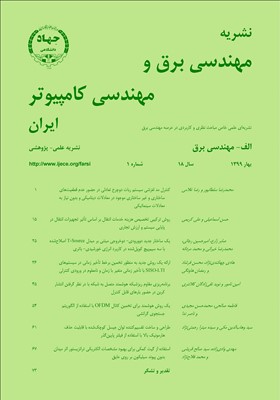روش ترکیبی تخصیص هزینه خدمات انتقال بر اساس تأثیر تجهیزات انتقال در پایایی سیستم و ارزش تجاری
محورهای موضوعی : مهندسی برق و کامپیوتر
1 - دانشگاه کاشان
2 - دانشکده مهندسی برق و کامپیوتر
کلید واژه: بازار برقتخصيص هزينه خدمات انتقالظرفيت تجاريظرفيتهای پاياييظرفیت پیشامدظرفیت آینده,
چکیده مقاله :
با ظهور بازارهای برق و ایجاد محيط رقابتي در سیستمهای قدرت، تخصیص مناسب هزینههای انتقال بین کاربران شبکه (مصرفکنندگان و تولیدکنندگان) اهمیت زیادی دارد تا به سرمايهگذاري مؤثر در شبکه انتقال کمک کند. در این مقاله، روشی ترکیبی برای تخصيص هزينه خدمات انتقال بر اساس تأثیر تجهیزات انتقال در پایایی سیستم و ارزش تجاری آنها پیشنهاد شده است. در روش پیشنهادی، اولاً منافع کاربران شبکه در بازار برق و به عبارتی دیگر، مبنای تجاری در تخصیص هزینهها مورد توجه قرار گرفته است. ثانیاً بر اساس تأثیر تجهیزات شبکه در پایایی سیستم شامل مؤلفههای امنیت و کفایت سیستم و نفعی که کاربران از این مؤلفهها میبرند، تخصیص انجام شده است. برای پیادهسازی روش پیشنهادی، ظرفیت هر تجهیز شبکه شامل خط و ترانسفورماتور به چهار بخشِ ظرفیت تجاری، ظرفیت برای پیشامد به منظور حفظ امنیت، ظرفیت برای آینده به منظور حفظ کفایت و ظرفیت نامعتبر تقسیم میشود. برای نشاندادن کارایی روش ترکیبی پیشنهادی، مطالعات عددی در شبکههای نمونه سه شینه و 30 شینه IEEE انجام و نتایج آن با روشهای دیگر مقایسه شده است.
With the advent of electricity markets and the creation of a competitive environment in power systems, proper allocation of transmission cost among network users (consumers and producers) is essential to help the investment of transmission network, effectively. In this paper, a hybrid method for transmission cost allocation based on the effect of transmission facilities in system reliability and their merchant value is proposed. In the proposed method, first, the users' benefit in the electricity market and in other words, the merchant benchmark in cost allocation has considered. Second, cost allocation considering the effect of facilities in system reliability which are consist of factors of system security and adequacy and the benefit of users with these factors is done. For the implementation of the proposed method, the capacity of all facilities includes lines and transformers are divided into four sections consist of merchant capacity, contingency capacity for maintaining security, future capacity for maintaining adequacy and invalid capacity. The numerical results in a 3-bus and the IEEE 30-bus test system are presented to demonstrate the effectiveness of the proposed method and compare to other methods.
